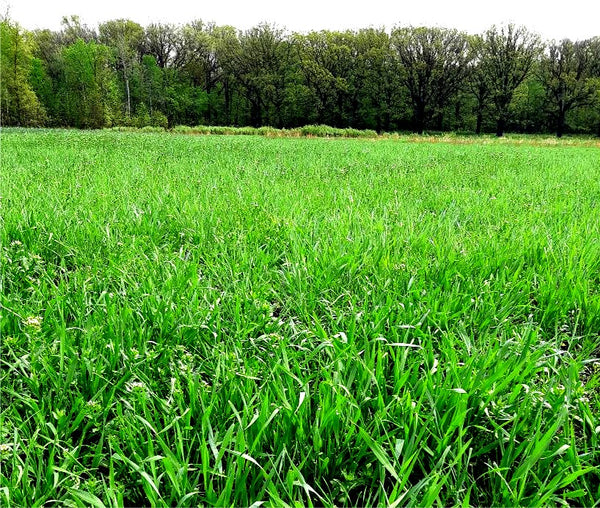Planting Cover Crops and Green Manures In The Garden

Garden area with a vetch cover crop planted in spring.
Cover crops are plants specifically grown in a garden to help improve the soil’s physical structure, health and fertility. There are many species of cover crops, each with different characteristics that make it a good choice for planting.
As cover crops grow, they accumulate and hold onto nutrients such as nitrogen, phosphorus, potassium, and various micronutrients. The growing plants also do a fantastic job of preventing soil erosion, eliminating weed problems, and providing critical habitat for various beneficial insects.
Cover crops can be tilled or turned under to return nutrients to the soil. Soil organisms break down the plant matter over time, making these nutrients available to future vegetable crops. Working cover crops into a garden also increases soil organic matter, improving the soil’s overall physical structure. This process leads to better water holding capacity, improved drainage and looser soil that is better suited to vegetable growing.
Cover crops can be easily added to the garden’s annual vegetable rotation, or planted in a fallow garden area. They grow easily and can be planted in spring, summer or fall.
Green Manures
Green manures are one type of cover crop grown specifically to improve soil fertility, although they often provide additional benefits as well. Most green manures are legume species such as clover, alfalfa, vetch, peas or beans. Legumes are unique because they increase the levels of soil nitrogen due to a symbiotic relationship between the plants and certain types Rhizobium bacteria. These bacteria live on the roots of legume plants, forming nodules and converting atmospheric nitrogen for the plants to use.

Small garden bed planted with a mix of legume species including crimson clover & red clover.
Choosing a Cover Crop
There are many different species of cover crops, and choosing the best one for your vegetable garden depends on when it will be planted and what the goals are. Cover crops can be planted before vegetables are seeded, after harvest, in place of a vegetable crop, or in a fallow garden area not being used.
Warm-season cover crops such as buckwheat can be planted in spring or summer, before or in place of a vegetable crop. They grow quickly in most home gardens, preventing weeds from establishing, protecting bare soil, and providing flowers for pollinators.
Cool-season cover crops can be planted in early spring or late summer to early fall, before vegetables are seeded or after they are harvested. Late-season cover crops are planted early enough to establish some growth before the winter and can help prevent soil erosion and crusting during fall rains. Depending on the species, plants may be killed by freezing winter temperatures or become dormant and resume growth in the spring.
Fall-planted cover crops that are winterkilled (e.g., oats) are a good option for gardeners wanting to work the soil immediately in spring in order to plant early crops such as radishes, greens or peas. The plant materials tend to breakdown easily over the winter, making tillage easy in spring.
Hardy fall-planted cover crops such as fall rye do not winter kill and will start plant growth again in the spring. This is a good choice for gardeners who want living roots in the soil for as long as possible. By having live plants growing in late winter and early spring, the soil will dry sooner, soil structure will be improved, and the maximum amount of organic matter will be added.

Fall Rye planted before winter and growing in spring.
For cover crops that survive the winter, it is best to till them early in spring before flowering and seed head formation. Plants become more fibrous at this stage, making them much harder to till and break down. Since tillage is usually required, warm-season vegetables such as tomatoes, peppers and squash are often planted following the termination of the cover crop.
Planting a Cover Crop
Before planting, it is best to clear the growing area of any large stones or debris. Proceed to rake the area smooth and broadcast seed according to the recommended seeding rate. The soil can then be tamped down or raked again to incorporate the seeds into the soil. The area should be lightly watered to firm the seedbed and improve soil-to-seed contact. Care should be taken to not over-water the seeded area to prevent compaction and crusting.
Termination
Once the cover crop is growing, it is important to decide when to mow or till the plants. Most gardeners choose to terminate the cover crop just before or during flowering. This prevents the plants from self-seeding and causing potential weed problems later. Plants can be cut by hand, with a trimmer or with a mower. Once the vegetation has been cut, incorporate the plants into the soil using a pitchfork or rototiller. Alternatively, the plant materials can be left on the surface as a mulch that large seeded vegetables or transplants can be planted into. When direct seeding after tillage, allow two to three weeks for the cover crop vegetation to decompose.

A pollinator mix cover crop at flowering and ready to mow or till into the soil.
For more information on cover crops, visit our other cover crop articles.
About the Author: John Côté owns and operates John Boy Farms with his family who have been farming the same land for over 140 years. As an agronomist and experienced farmer, he helps others learn how to grow garlic and cover crops successfully. He has written many articles and is the author of The Master Guide to Growing Big Garlic.
